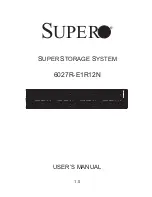
170
Item
Description
Mode
Set the operating mode of STP:
•
STP
—Each port on a device sends out STP BPDUs.
•
RSTP
—Each port on a device sends out RSTP BPDUs, and automatically migrates
to STP-compatible mode when detecting that it is connected with a device
running STP.
•
MSTP
—Each port on a device sends out MSTP BPDUs, and automatically
migrates to STP-compatible mode when detecting that it is connected with a
device running STP.
Max Hops
Set the maximum number of hops in an MST region to restrict the region size.
The setting can take effect only when it is configured on the regional root bridge.
Path Cost Standard
Specify the standard for path cost calculation. It can be Legacy, IEEE 802.1D-1998,
or IEEE 802.1T.
Bridge Diameter
Any two stations in a switched network are interconnected through a specific path
composed of a series of devices. The bridge diameter (or the network diameter) is
the number of devices on the path composed of the most devices.
After you set the network diameter, you cannot set the timers. Instead, the device
automatically calculates the forward delay, hello time, and max age.
When you configure the bridge diameter, follow these guidelines:
•
The configured network diameter is effective for CIST only, not for MSTIs.
•
The bridge diameter cannot be configured together with the timers.
Timers
Configure the timers:
•
Forward Delay
—Set the delay for the root and designated ports to transit to the
forwarding state.
•
Hello Time
—Set the interval at which the device sends hello packets to the
surrounding devices to make sure the paths are fault-free.
•
Max Age
—Set the maximum length of time a configuration BPDU can be held by
the device.
When you configure timers, follow these guidelines:
•
The settings of hello time, forward delay and max age must meet a certain
formula. Otherwise, the network topology will not be stable. HP recommends that
you set the network diameter and then have the device automatically calculate
the forward delay, hello time, and max age.
•
The bridge diameter cannot be configured together with the timers.
Instance (Instance ID,
Root Type, and Bridge
Priority)
Set the role of the device in the MSTI or the bridge priority of the device, which is one
of the factors deciding whether the device can be elected as the root bridge.
Role of the device in the MSTI:
•
Not Set
—Not set (you can set the bridge priority of the device when selecting this
role)
•
Primary
—Configure the device as the root bridge (you cannot set the bridge
priority of the device when selecting this role)
•
Secondary
—Configure the device as a secondary root bridge (you cannot set the
bridge priority of the device when selecting this role).
Summary of Contents for HP 830 Series
Page 37: ...25 Figure 18 Configuration complete ...
Page 70: ...58 Figure 49 Displaying the rate settings of ports ...
Page 78: ...66 Figure 56 Configuring the monitor port ...
Page 82: ...70 Figure 59 Switching to the management level ...
Page 87: ...75 Figure 64 Displaying port traffic statistics ...
Page 167: ...155 Figure 154 Displaying the current voice VLAN information ...
Page 304: ...292 Figure 280 Traceroute operation result ...
Page 321: ...309 Request timed out Ping statistics for 10 0 0 1 Packets Sent 4 Received 0 Lost 4 100 loss ...
Page 343: ...331 Figure 330 Ping operation summary ...
















































